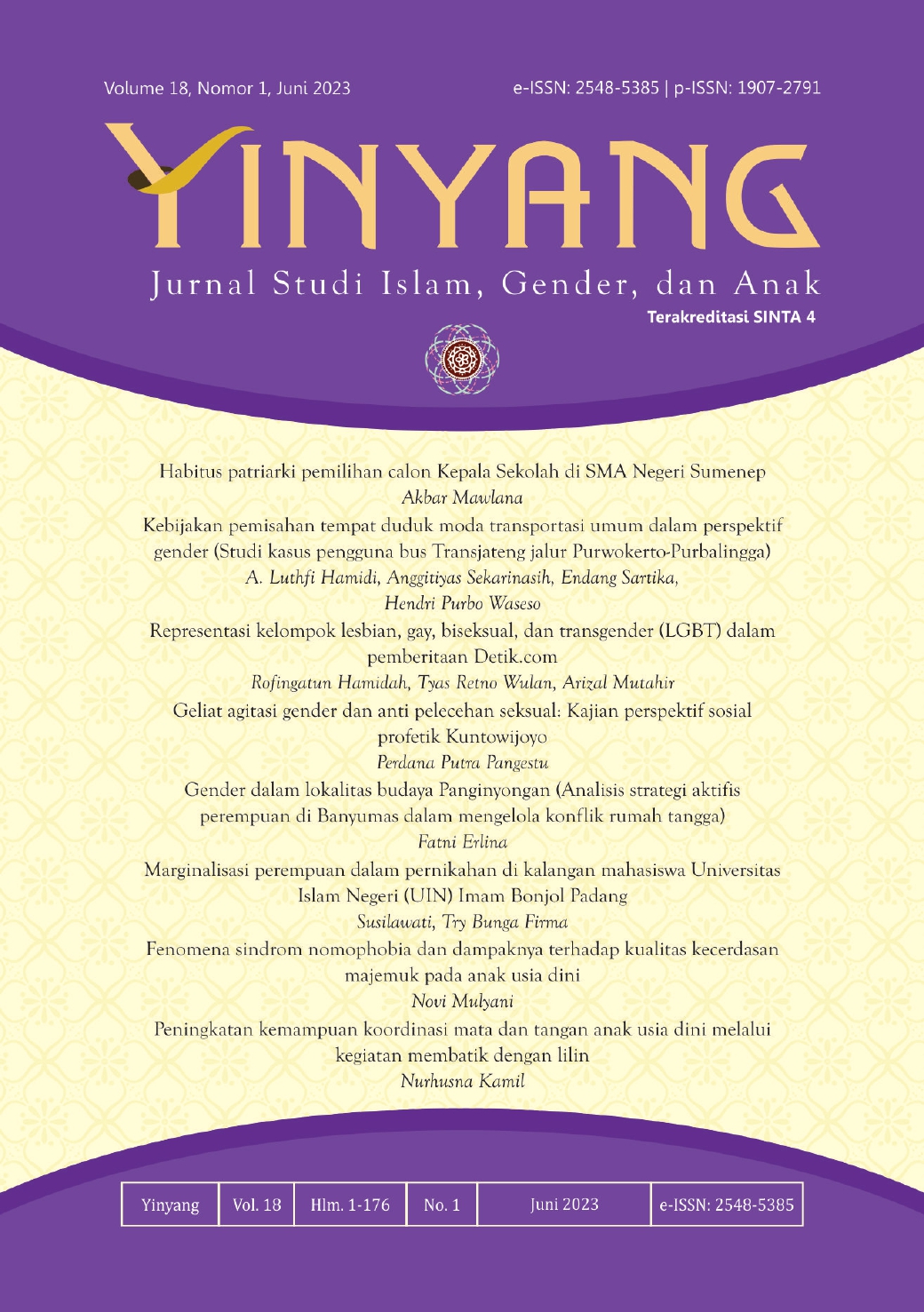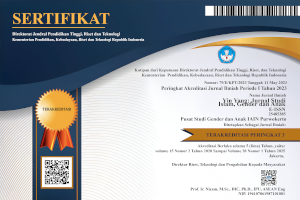Fenomena sindrom nomophobia dan dampaknya terhadap kualitas kecerdasan majemuk pada anak usia dini
DOI:
https://doi.org/10.24090/yinyang.v18i1.8029Keywords:
Early Childhood, Multiple Intelligences, Nomophobia SyndromeAbstract
This study reveals the impact of nomophobia syndrome on the quality of early childhood multiple intelligences in students at R.A. Perwanida Tamansari Karanglewas Banyumas. The research method used is descriptive qualitative by relying on data sourced from research informants through interview, observation, and documentation techniques. The main informants in this study were six students and their parents who were determined by purposive sampling. The findings of this study are (1) Nomophobia syndrome in students at RA Perwanida Tamansari Karanglewas was not found in its entirety. However, based on existing qualitative indicators, it can be classified into two types, namely students who have the potential to have nomophobia syndrome and students who have symptoms that lead to nomophobia syndrome; (2) The dominant multiple intelligences in students at R.A. Perwanida Tamansari Karanglewas there are six intelligences, namely spiritual intelligence, language intelligence, kinesthetic intelligence, musical intelligence, interpersonal intelligence and logical-mathematical intelligence. The six intelligences are seen when students carry out school activities either through routine activities, spontaneous activities, or exemplary activities; and (3) The impact of nomophobia syndrome on students at RA Perwanida Tamansari Karanglewas on three children's multiple intelligences, namely, first, students who are potentially affected by the nomophobia syndrome do not see a significant impact on their language, kinesthetic and interpersonal intelligence. Second, students who lead to mild symptoms of nomophobia syndrome seem to have an impact on language intelligence and interpersonal intelligence. As for kinesthetic intelligence, it looks pretty good.Downloads
References
Aarthi, K., Prathap, L., Jothi Priya, A., & Preetha, S. (2020). Nomophobia and its Impact on Health and Mind - A Structured Review. European Journal of Molecular and Clinical Medicine, 7(1), 334–341. https://ejmcm.com/article_2204.html
Adnan, M., & Gezgin, M. (2016). A modern phobia: prevalence of nomophobia among college students. Journal of Faculty of Educational Sciences.
Amalia, R., & AH, N. M. (2019). Peran Orang Tua dalam Pengenalan Budaya Literasi untuk Meningkatkan Kecerdasan Bahasa Pada Anak Usia Dini 5-6 Tahun. ThufuLA: Jurnal Inovasi Pendidikan Guru Raudhatul Athfal, 7(2), 223. https://doi.org/10.21043/thufula.v7i2.5638
Ardiana, R. (2022). Pembelajaran Berbasis Kecerdasan Majemuk dalam Pendidikan Anak Usia Dini. Murhum: Jurnal Pendidikan Anak Usia Dini, 3(1), 1–12.
Darmisih, E. S., & Fajrie, N. (2021). Strategi Penerapan Kecerdasan Natural Berbasis Audio Visual Pada Masa Covid-19 Di Kb Pertiwi Bersinar. Digital Learning Untuk Pembangunan Berkelanjutan Menuju Merdeka Belajar Kampus Merdeka, 1, 14.
Dewi, R. V. K., Mustaring, D. I., & Sunarsi, D. (2021). Metode Stimulasi Multiple Intelligences Bagi Anak Usia Dini. Cipta Media Nusantara.
Fathonah, M. F., Wahyuningsih, S., & Syamsuddin, M. M. (2020). Efektivitas Media Audio Visual Terhadap Kecerdasan Visual Spasial Anak Usia 5-6 Tahun. Kumara Cendekia, 8(2), 142. https://doi.org/10.20961/kc.v8i2.39789
Gezgin, D. M., & Çakır, Ö. (2016). Analysis of nomofobic behaviors of adolescents regarding various factors. Journal of Human Sciences. https://doi.org/10.14687/jhs.v13i2.3797
Hafni, N. D. (2018). Nomophobia, Penyakit Masyarakat Modern. Jurnal Al–Hikmah, 6(2), 41–50.
Harfiani, R. (2021). Multiple Intelligences Approach (Melejitkan Potensi Kecerdasan Anak Usia Dini). Umsupress.
Kazem, A. M., Emam, M. M., Alrajhi, M. N., Aldhafri, S. S., AlBarashdi, H. S., & Al-Rashdi, B. A. (2021). Nomophobia in Late Childhood and Early Adolescence: the Development and Validation of a New Interactive Electronic Nomophobia Test. Trends in Psychology, 29(3), 543–562. https://doi.org/10.1007/s43076-021-00068-0
Lestiawati, I. M. (2021). Kurikulum PAUD. Insan Cendekia Mandiri.
Lodewijk, D. P. Y. (2022). Mengembangkan Potensi Kecerdasan Linguistik Pada Anak Sebagai Optimalisasi Kecerdasan Majemuk. Guepedia.
Mahamood, A. F., Ali, M. E. M., Yakoob, T. K. S. T., Ramli, A. J., & Adhhar, S. N. A. (2021). Nomophobia Dalam Kalangan Anak-anak Di Batu Pahat Johor. Journal of Humanities, Language, Culture and Business (HLCB), 5(16).
Mendoza, J. S., Pody, B. C., Lee, S., Kim, M., & McDonough, I. M. (2018). The effect of cellphones on attention and learning: The influences of time, distraction, and nomophobia. Computers in Human Behavior. https://doi.org/10.1016/j.chb.2018.04.027
Milles, M. B., & Huberman, A. M. (1993). Analisa Data Kualitatif. UI-Press.
Muhaemin, & Fitrianto, Y. (2022). Mengembangkan Potensi Peserta Didik Berbasis Kecerdasan Majemuk. Penerbit Adab.
Novita, D., & Martiastuti, K. (2021). Fenomena Nomophobia Pada Anak Usia Dini Berdasarkan Tipologi Wilayah Dan Hubungannya Terhadap Perilaku Prososial Dan Antisosial. JKKP (Jurnal Kesejahteraan Keluarga Dan Pendidikan), 8(01), 91–107. https://doi.org/10.21009/jkkp.081.09
Sari, I. P., Ifdil, I., & Yendi, F. M. (2020). Konsep Nomophobia pada Remaja Generasi Z. JRTI (Jurnal Riset Tindakan Indonesia), 5(1), 21–26.
Sugiyono. (2014). Metode Penelitian kuantitatif, kualitatif dan R & D. Alfabeta.
Yildirim, C., & Correia, A. P. (2015). Exploring the dimensions of nomophobia: Development and validation of a self-reported questionnaire. Computers in Human Behavior. https://doi.org/10.1016/j.chb.2015.02.059
Downloads
Published
How to Cite
Issue
Section
License
Copyright (c) 2023 Novi Mulyani

This work is licensed under a Creative Commons Attribution-ShareAlike 4.0 International License.
Authors who publish with this journal agree to the following terms: Authors retain copyright and grant the journal right of first publication with the work simultaneously licensed under a Creative Commons Attribution-ShareAlike 4.0 International License that allows others to share the work with an acknowledgment of the work's authorship and initial publication in this journal.


















